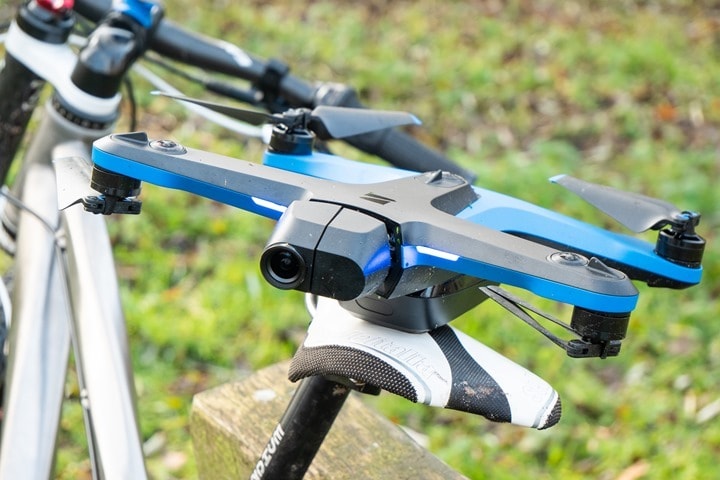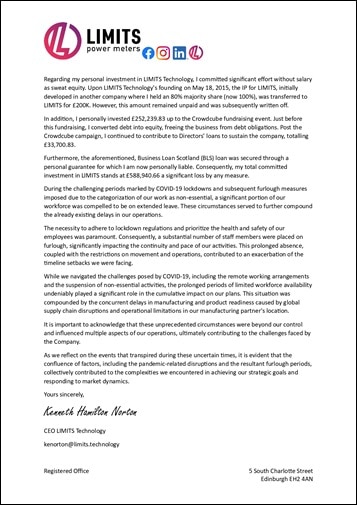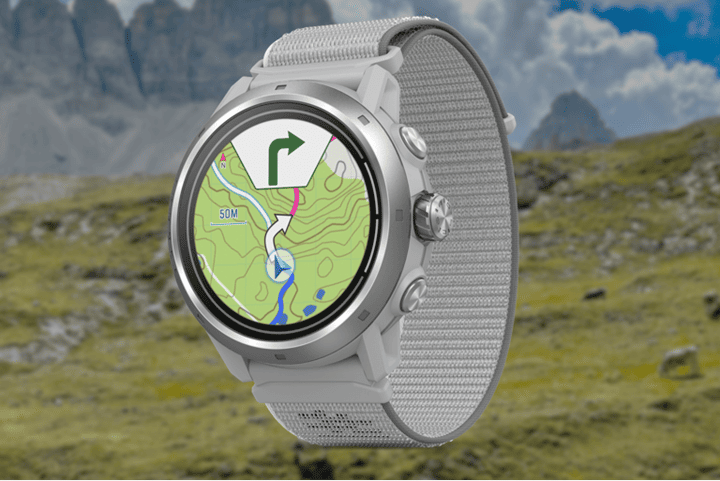Here’s a few tech tidbits from today, the last few days, and the last week or so (in the case of Skydio) that are worthy of note. We’re back at the point where companies are warming up for what I suspect will be a very busy fall. Albeit, two of these involve companies leaving the space. But hey, can’t win them all.
LIMITS Dissolves:
(Image above: From Limits marketing pages)
LIMITS has announced that it’s dissolving the company. The entity originally attempted to launch a power meter back in 2015, via Kickstarter. It didn’t go well. The idea was for a small pod that sat between the pedal and crank arm, making it universally compatible with any pedal or crank arm combination.
After some failures, the company did some ownership/management changes, and then launched a secondary product aimed at fixing the first product. That didn’t end well either, which the company attributes to supply chain issues during COVID. Following that, the company did try and re-invent itself a bit more. Despite the company being pretty hostile early on, the management/etc changes did seem to reinvent them a bit during those middle years. Albeit, I never ended up testing the secondary iterations, as initial feedback from DCR Supporters indicated it was still problematic.
In any case, they sent out the letter below over the weekend. I do want to point out that, as is often the case with startups, the owners generally take a substantial loss themselves – no matter the industry. You can tap to expand each of the two pages for further detail:
(Thanks to the DCR reader and Limits Crowdcube who sent a copy of the letter in)
As I said many times back when it first launched, I’d love nothing better than cheap and accurate power meters. We do have inexpensive and accurate power meters today from the likes of Stages and 4iiii (and many more), costing a fraction of what power meters used to. But the process to develop an accurate and reliable power meter remains immensely difficult, costly, and time-consuming. After all, even cycling industry giant Shimano is unable to do so.
I thought it was interesting that they noted they approached both Wahoo and Peloton, but didn’t get traction. A number of failed power meter companies have tried approaching other industry veterans, but it’s kinda a hard pitch unless you have very specific IP (patents) that are of use, or a functional/tested product.
One minor footnote to this story, is that Limits currently holds the distinct honor of being the only company to insinuate legal action after I repeatedly pointed out they were misleading consumers and outright lying in their early Kickstarter campaign.
COROS New Beta Firmware:
COROS has launched a new beta firmware for some of its watches. The company iterated on a few different public betas over the last few days, culminating in one today that includes ‘turn-by-turn’ navigation on their watches. In addition, they’ve added the following other features in beta:
– Added Turn-by-Turn Navigation Alerts (except the APEX 42mm/46mm)
– Added custom watch face creation (such as using your own photos)
– Added new stats summary page in COROS smartphone app
– Added new stats+picture sharing from COROS App (overlaying activity stats on a photo for sharing)
– Added elevation-based structured workouts (e.g., intervals with 200m of elevation gain per repeat)
– Added ability to update Strava notes with COROS training load metrics
– Switched resting heart rate data to be based on sleeping RHR
– Added favorite locations options in smartphone app
– Added ability to merge start/end points in map on smartphone app
– Adds support for Stryd metrics ‘Impact Loading Rate’ and ‘Lower Body Stress Score’
– Sped up WiFi speeds for firmware installs
– Increased longest activity recording time from 200 hours to 1,200 hours
You can join the beta here.
Now, when it comes to navigation in watches, there’s somewhat of a tiered system, and COROS has been working their way up that tier structure over the last few years since the launch of the COROS Vertix 2. Roughly speaking, the tiers are:
Level 0: No pre-defined routing/navigation, albeit perhaps some level of trackback/save-my-bacon
Level 1A: Breadcrumb trail that you follow on a ‘blank’ background (no map, no turn notifications), usually off-course alerts
Level 1B: Breadcrumb trail that you follow on a ‘blank’ background (no map, but with turn notifications), usually off-course alerts
Level 2A: Breadcrumb trail notification that you follow on a background map (has some maps shown, but think of it like a transparency, the watch doesn’t know what’s actually in the map data-wise, it’s just an image behind the breadcrumb trail. No turn notifications.
Level 2B: Breadcrumb trail notification that you follow on a background map (has some maps shown, but think of it like a transparency, the watch doesn’t know what’s actually in the map data-wise, it’s just an image behind the breadcrumb trail. With turn notifications.
Level 3 and beyond: Full routing with full maps, where the watch is aware of all the trails/data on the map, and can route or re-route on the fly if a turn is missed. Plus turn notifications, points of interest, heat maps, etc…
Different companies are at different levels, and there’s obviously a bunch of nuance between these levels (for example, in this new iteration COROS doesn’t appear to provide distance till turn, whereas Garmin/Polar/Suunto do). Jumping from one level to the next generally takes years in this industry, and going from Level 2 to even the most basic version of Level 3 is typically an 18-24 month process before routing is minimally trustable.
Roughly speaking, here’s where a few watches are in today’s landscape using native apps (if on Apple Watch or Samsung watches with 3rd party apps there’s far more functionality):
Level 0: Apple Watch (has track back functionality, plus ability to as-the-crow-flies route to saved waypoints).
Level 1B: Garmin Instinct series, Garmin Forerunner 255/265 series, Polar watches, most Suunto watches
Level 2A: COROS watches prior to today, they had a background map, but didn’t have turn notifications
Level 2B: Suunto Vertical, Suunto 7, COROS watches after today, Samsung Watch5 Pro (other Samsung watches have none).
Level 3: Garmin Fenix series, Garmin Forerunner 945/955/965, and a bunch of other Garmin watches
In other words, COROS essentially added notifications of an upcoming turn. This is useful to prevent you from missing a turn and having to backtrack with the off-course warning. It’s also in line with what Polar and Suunto have had for a few years (depending on route provider). For all the Tier 1/2 methods, they simply alert you to being off-course, and tell you which direction (compass-wise) to go to get back on course. Whereas Tier 3 watches can actually re-route you on the fly on new trails/routes/etc… A Tier 2 watch doesn’t actually know anything about the map data, it’s just a background wallpaper, whereas a Tier 3 watch does.
Anyway, enough for now. I did try the turn-by-turn instructions numerous times over the last few days on the current beta before it was released (and tried again now), and was unable to get it to work in any manner using imported routes, new routes, changed routes, offering chocolates to it, or anything else. COROS was unable to provide any clarity there. Such is beta.
Skydio Leaves Consumer Space:

This happened about 10 days ago, but given I was on a trip in the mountains, I wanted to at least mention it somewhere here – since Skydio drones have been really the best option when it comes to autonomous sports tracking drones, at least from an obstacle avoidance and tracking standpoint. While DJI has steadily made improvements, Skydio remains quite far ahead in the tracking realm (whereas DJI remains quite far ahead in image quality).
However, the writing has been on the wall for quite some time that US-based Skydio wanted to leave the consumer drone space to focus on their other (likely far more profitable) markets, notably public safety, enterprise, and military. Skydio consumer units have been out of stock since this winter, and finally Skydio announced the end of their consumer efforts a bit over a week ago, in a letter from their CEO. Keeping in mind the company made their introduction and name via the consumer space:
“Four years after its launch, Skydio 2’s follow-and-film capability and autonomous cinematography features like KeyFrame are still in a class all on their own. Watching our consumer customers use our drones to capture photos and videos that would be impossible to achieve any other way while they bike, climb, run, drive, and ski in some of the most beautiful parts of the world has been one the greatest joys of our work.
While Skydio 2 has been an incredible success in enabling new kinds of content capture, Skydio drones are also having a transformative impact for over 1,500 enterprise and public sector customers, putting sensors in dangerous and important places to perform inspections, find missing children, and protect our troops around the world. Our drones are making the core industries that our civilization runs on – public safety, transportation, energy, construction, and defense – safer and more efficient. And it’s becoming more and more clear every day that we need trusted, secure drones to meet these critical applications. The impact we’re having with our enterprise and public sector customers has become so compelling that it demands nothing less than our full focus and attention.
As a result, I have made the very difficult decision to sunset our consumer business in order to put everything we’ve got into serving our enterprise and public sector customers.
This means that we will no longer offer our Skydio 2+ Starter, Sports, Cinema, or Pro Kits. We will continue to provide software and customer support for existing customers. We stand by all warranty terms, Skydio Care, and will continue vehicle repairs. Additionally, we will retain inventory of accessories for as long as we can to support the need for replacement batteries, propellers, charging cables, etc.
Commercial enterprises and public sector organizations can purchase the Skydio 2+ Enterprise Kit from their Skydio representative or reseller.
We will be forever grateful to every consumer who has purchased a Skydio drone. We hope you have enjoyed the product as much as we enjoyed building it and supporting you.
– Adam Bry”
In addition, they’ve posted a large FAQ on what it means here.
As I said in my recent DJI Air 3 review towards the end, I think this is a mistake that Skydio may regret. Undoubtedly, there’s a cost to maintaining the consumer space, or even being competitive in it. However, the exact same drone is still being used when sold as an ‘enterprise’ kit instead. More importantly though, while DJI is absolutely dominates in the consumer drone world (be it in the US market or elsewhere), and unquestionably produces the best overall consumer drones out there, they are in a precarious position.
There have been numerous volleys at reducing DJI’s ability to sell into the US market. Some of those volleys have succeeded, such as limiting federal agencies from purchasing DJI drones. We’ve seen numerous tech companies caught up in the political fray (rightfully or wrongfully is somewhat irrelevant here), and if I were Skydio, I’d be ensuring that if the political winds change just slightly (resulting in a Huawei-like outright ban). Skydio would have been in a better position to capitalize on that.
And perhaps they still have things up their sleeves on standby if such winds change. In their FAQ, when asked “Will there ever be another Skydio drone offering for consumers?”, they state:
“We are not able to share any updates about our future product roadmap. Please sign up for emails or follow us on social media to keep up to date on new product developments and other announcements.”
Albeit, that’s about as non-committal as you can get. But if there’s one truth about investors in Silicon Valley, it’s that they follow the money. And there’s a heck of a lot of money in the consumer drone business if the dominant entity is unable to sell drones to the US or beyond.
All that aside – it’s definitely a bummer to see Skydio step out. I’d have loved to see them make a much smaller drone, potentially using camera technology from GoPro, with whom they share a parking lot and basically a BBQ deck with, in California. As always, competition is good for consumers – and we now have one less competitor in a field that has very few serious competitors already.
With that – thanks for reading!
FOUND THIS POST USEFUL? SUPPORT THE SITE!
Hopefully, you found this post useful. The website is really a labor of love, so please consider becoming a DC RAINMAKER Supporter. This gets you an ad-free experience, and access to our (mostly) bi-monthly behind-the-scenes video series of “Shed Talkin’”.
Support DCRainMaker - Shop on Amazon
Otherwise, perhaps consider using the below link if shopping on Amazon. As an Amazon Associate, I earn from qualifying purchases. It doesn’t cost you anything extra, but your purchases help support this website a lot. It could simply be buying toilet paper, or this pizza oven we use and love.





















Ray, other than continuing lower prices, do you foresee any innovations in the power meter industry? Is there anything they can do to make something different while retaining accuracy?
The real question is, are there any training use-cases or research driving a new requirement not currently being met? From what I can tell current power meters do everything we need and a bunch of stuff that we don’t, and the same for running dynamics type stuff.
Innovation for innovation’s sake just leads to more toys for people to buy usually. I think it’s notable that Garmin Rally were essentially identical to Vector 3. I have both in the Keo cleat and there’s no discernable difference. The only thing I’d like to see is rechargeable batteries, ideally using the same magnetic charge lead as Shimano DI2
I don’t really think we’re gonna see much change in the power meter realm at this point, except slowly declining (lower) prices.
Had the LIMITS technology worked, that could have been compelling. And maybe technically it can, but they just didn’t have the manufacturing experience/etc to pull it off. One of the things that is a common thread when I talk with power meter companies, especially in the pedal realm (versus crank arms), is how challenging it is to scale up the production side of that from a tolerances and yield standpoint. I didn’t follow LIMITS too closely in the final years, so perhaps there were other aspects at play.
Accuracy-wise, I think we’re there. There are undoubtedly edge cases and such that individual companies can address, but on the whole, the market leaders have ‘solved’ accuracy. I suspect we’ll see more of a shift towards rechargeable as well, albeit frankly, I’d rather it just be a darn USB-C cable.
USB-C would need some kind of cap though which spells trouble (I know, DI2 has a cap, no idea why). Without a cap mud would get in which would be a pain.
I feel we need a standardised magnetic USB connector, all the variants are just 4 pin magnetic sprung connectors but every manufacturer thinks they should reinvent the wheel. That said, the old Suunto one was massive so I’m glad that didn’t stick. Whatever happens there, I don’t want to have to pack 12 different cables when I go on holiday just for my various bike tech
I can’t remember who recently (need afternoon coffee), but someone did do USB-C for a power meter recently. Under a cap of course, and the USB-C port is of course internally waterproofed like all of them.
I do agree a charging standard would be ideal. 4iiii had actually promoted one years ago, and even got Pebble on board. Then Pebble would kaput…and…yup.
The crazy thing is they’re all doing the exact same ordering of the 4 pins (following the USB standard!), and because it all goes to one of a couple of sizes of wires underneath, they’re even spacing the 4 pins more or less the same distance apart. The only thing that’s really different is the physical shape that the magnetic plug has to dock to. We’re agonizingly close to having a “USB-mag” standard.
– If you want to move a power meter between bikes your current option is to get pedal-based meters.
– Pedal-based meters add to the Q factor, which some people don’t like
– You’re still talking about switching pedals between bikes, which not everyone is comfortable doing spur of the moment
– If you want SPD pedals (or phrased differently, you want to choose your cleat type for your pedals) your options are hacking Assioma Duo-Shis or getting extremely expensive Garmins
– Anything that is not a pedal-based meter is precisely paired to the drivetrain it connects to. So for instance you can buy a left-side crankarm meter which is reasonably easy to move, but you’re not practically moving it between a road bike and a mountain bike.
I do think there’s room for more options for people who want to use oddball cleats, or officially use SPDs (the lack there baffles me), or just more ‘off-road’ oriented power meters in general. It would also be nice for those of us with N+1 bikes to have some sort of meter where at least the expensive bits could be as portable between bikes as the bike computer is.
Assioma Duo-Shi paired just fine to my Shimano A530s. The only “hacking” was not being listed as compatible.
I was one of the early backers of the original Limits PM, but by the time I received it I’d got fed up of waiting and nervous of some of the initial reports so had bought a Stages PM. The Limits sat unopened in its box until I sold it on eBay (and actually walked away with a small profit) – I still have pangs of guilt over the crock of pooh that the buyer would have ended up with, even though I didn’t know at the time just how bad it was.
I’m looking in my newly updated Garmin Connect Android (4.70). When I’m in “Edit an Activity” it includes “Convert to Multisport Activity.” Does this sound new to you? I can’t remember seeing that option before. I also looked at the web version, and I’m seeing the option there too. Maybe I’ve been overlooking it all this time.
Convert to Multisport has been in Connect for years. The recent update just shuffled a bunch of items around.
As an aside, the redesign of the phone app (on both platforms) has, shall we say, not been popular…
Has any of their changes ever been popular? ;-) And thanks, Otto. Guess they put it some place I could finally see it, because I never knew of the option before.
The Limits debacle reminded me about IQ^2. Do we have any updates on that other than the “official” stuff on their Indiegogo campaign?
I’m still getting updates from backing the original KickStarter campaign. Last one was July 21st.
They have a US distributor (link to powermeterpedals.com), which I found out about by seeing quite a few ads for them in my Facebook feed. Who knows what you get when you order; I have no interest in doing so.
I am positively surprised that Coros brought the Stryd Gen 5 metrics to their watches. After the launch of their own Pod I expected that they won’t do that. This gives me hope that Stryd will survive even in a power-from-the-wrist-world.
Thank you for laying out the navigation tiers! I’ve been trying to figure this out from the specs of different watches but it’s hard to distinguish. I have a Suunto Ambit3 that I’m looking to upgrade, but this confirms that on terms of navigation, going to a Suunto 9 or a Polar Grit X doesn’t add me much in terms of navigation. Which is a shame considering how old the Ambit3 Sport is (or very surprising of how “advance” the Ambit3 Sport was in terms of navigation back then?!)
You should refer to those tiers when you review watches.
Thanks.
Yeah, I’ve gotta find a way to tidy up that tiers a little bit to make it slightly easier to understand.
But you are correct, going from Ambit 3 to Suunto 9/Grit X doesn’t get you a ton per se, but does get you the ‘notice’ to turn from certain platforms. Whereas if you went up to a Suunto Vertical, then you’d get the background maps with topo detail, as well as the notices too. It’s still not full on-board corrective routing, but it’ll keep you on the trail, and yell at you if you go off the trail.
The Pace 2 is a tier lower: no background maps, just breadcrumb and off track notice.
Yeah, Level 1A in that tier system: No maps, no TBT, but will usually give off-track notice.
Very sad to see Skydio go.
Does anyone have any ballpark numbers for the consumer drone market size? Anecdotally it feels like the prosumer use has levelled off after the initial wave of regulation – but this is of course very much geography dependent.
There’s some industry stuff here and there that comes out from the IDC’s of the world, but I haven’t looked at it recently.
I agree that I think we’ve mostly seen things level off as well, with the most growth coming from the smaller Mini-style drones (e.g. DJI Mini 3 Pro).
Lots of firmware updates for COROS. I really like my Pace 2 watch. Unfortunately, I will look elsewhere since the company has no current plans to allow direct data uploads to Today’s Plan which my coach uses. Looking to Garmin since they play nice with everyone- including FORM goggles for open water swim data.
hey there Ray,
so coros as a workout platform, athletic trainer, data analytics, whatever sucks absolute donkey balls right now. And it has for a half year at this point. The analytics platform, evolabs, just spits out useless garbage at this point. I’ve emailed CS about it and have had nothing but silence about it. Other people said they had heard about an august fix. but august came and went and …. nothing. Have you noticed anything goofy on your end, heard anything, can you give those of us in the dark any shred of hope? thinking of switching back to suunto or garmin.
Aside from that, please push people away from the crap product that is coros in it’s current form. It’s not fair to recommend it to anyone at this point.
I guess I’d divide up things into two camps:
A) When using a COROS device, is the technical side of things/platform useful (e.g. can it record files/track/etc). For that, it tends to work fairly well overall.
B) Are their physiological metrics accurate/useful? This is of course much more challenging, but I think there’s mostly broad agreement that some of the metrics COROS has pointed at are, at best, light in details and support. It’s something I’ve talked about in some of the reviews. They’ve tried to address some portions of it, but there’s lots of catches and gotchyas. Obviously, some people will say the same about any platforms metrcs (e.g. Garmin/Whoop/Polar/Suunto/TrainingPeaks/etc…), but I think on the whole those other platforms do a better job at outlining the detail and foundations of what they are doing. We can debate whether or not the individual metric is useful in training/racing, but at least most of those metrics have data behind them. This is something we don’t see COROS doing.